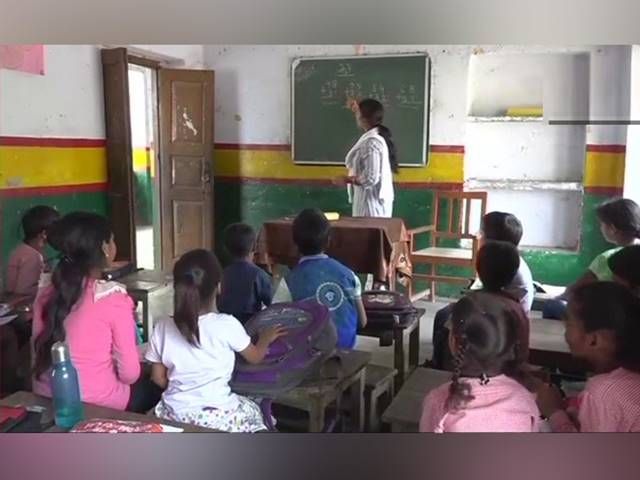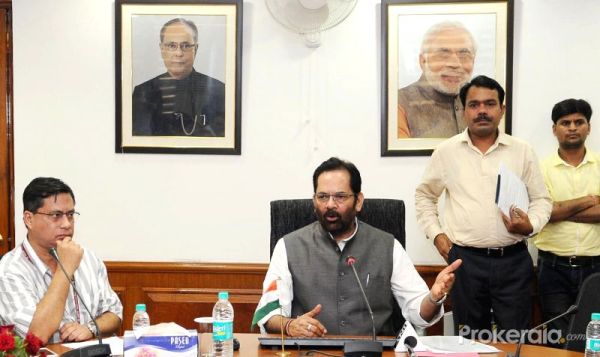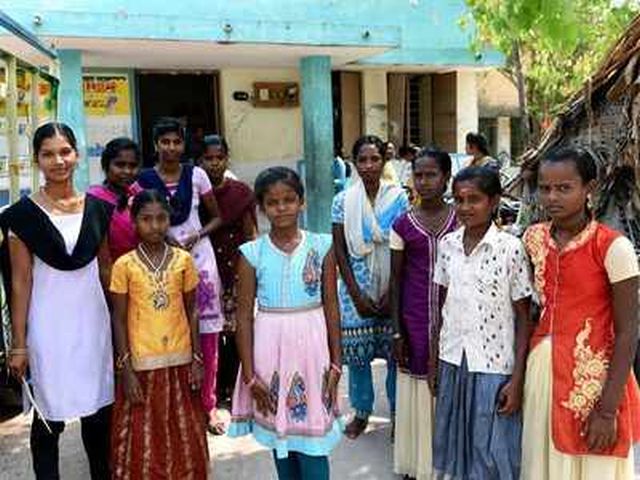
by Editor | May 25, 2021 | News

A view of a Delhi Government School.
By Nivedita Singh,
New Delhi : When Roshan Lal, a 40-year-old rickshawpuller, got his son Rakesh admitted to a government school in Delhi, all he wanted for him was to get a decent education. Since he could not afford to pay for a private school, all that was on his mind was that “government school mein kuch toh seekh hi lega” (at least, he would learn something there).
But, today, Roshan is a happy man because his son, now in Class VI, is doing well in school and is even able to teach him a thing or two. He feels elated that many of his son’s teachers are even being trained abroad.
Teachers and principals from over 1,000 Delhi government schools have so far been sent for training to Singapore and Finland, countries that are renowned for their pioneering teaching methods.
Many feel it has improved teaching methods as well as the quality of education imparted at government schools, hitherto infamous for their poor and archaic standards of teaching and rote learning methods, and that such training at different platforms enhances teachers’ pedagogic skills and keeps them abreast with the contemporary knowledge in their domain areas.
“I got to know from my son that his teachers are going abroad for training. I am happy with the idea as it will help in improving the quality of education he is getting currently,” Roshan told IANS.
“While poor people like us cannot afford private schools, it is good to know that even government schools are now competing with private ones and our children are learning from good teachers. Even private school teachers don’t go abroad for training,” he said.
Many Delhi government schools, with fresh coats of colourful paint on their walls, now not only have comparable infrastructure to private schools, but their course curricula are also transforming. They now also have a “Happiness Curriculum” designed by a team of 40 Delhi government school teachers and educators over a period of six months.
As part of this curriculum, students between Nursery and Class VIII now have a 45-minute “happiness period” which includes meditation, storytelling, question-and-answer sessions, value education and mental exercises.
Raju Yadav, a small shop-owner in Laxmi Nagar, feels excited with the focus on teachers’ training.
“My wife and I are not educated. It is also difficult for me to afford tuition classes. My daughter, Swati, is studying in a government school in Class II. The teachers getting training is a good thing. The more the teacher will know, the better they will teach, and the better our kids will learn,” he said.
The Aam Aadmi Party (Common Man’s Party, AAP), which came to power in Delhi in 2015, made the improvement of the education system one of its priority areas by investing in infrastructure — including classrooms and other facilities like playgrounds and swimming pools — while also upgrading teachers’ skills.
Delhi’s Education Minister Manish Sisodia has repeatedly stressed on the need to improve education system and, during his first budget speech, when he doubled the government’s expenditure on education, had said “the money spent on education and health is not an expense, but an investment into the well-being of coming generations”.
According to Sisodia, the goal of making government schools better than private schools does not end with improving infrastructure and recruitment of teachers.
“Since the core of the educational improvement process lies in building capacity of teachers, the government would train teachers and principals at the best universities in the world like Harvard, Cambridge and Oxford,” he had said.
The first to receive international training was a group of 200 teachers who the government called “mentor teachers”. The aim was to leverage their creative expertise to enhance the pedagogic and academic capacities of over 45,000 Delhi government school teachers.
Each mentor teacher received training in Mumbai, Bengaluru, Jaipur, Ahmedabad and Singapore. They were then assigned to teachers at five to six schools. These 200 mentors have trained thousands of teachers over the last two years.
Manu Gulati, who went to Singapore for training in August last year and is now a mentor teacher, said after the training, she feels motivated and encouraged to perform better.
“The general feeling is that by investing in their training, the government is showing its trust in the teachers,” Gulati, who started her teaching career in 2011, told IANS.
“In terms of calibre, teaching aptitude, content knowledge and pedagogy skills, government school teachers are no less than those at private schools,” she proudly proclaimed.
Among the few ground-breaking improvements, she said, was the feedback from the students. She said a teacher’s job is not just limited to providing knowledge and skills to students, but also to provide them emotional and psychological support, something the training helped teachers with.
Medha Parashar, another mentor teacher who went to a number of training sessions, said: “The teacher is no more the centre of teaching, but the students are. Teaching is not mechanical now, it is interactive.”
“Through various trainings, we learned about 45 methods of teaching in a class, and can use any of these,” Parashar, who has been a teacher for the past 27 years, said.
The training, Gulati said, gives a new vision and purpose to the teachers. The benefit of training teachers had, in turn, positively impacted hundreds of thousands of students of not-so-well-off families in the capital who had earlier been deprived of quality education.
However, Parashar said, it will take some time for changes to be clearly visible. “We are dealing with living beings. No change will happen overnight as small children are involved. Change will happen with time,” she said.
(The weekly feature series is part of a positive-journalism project of IANS and the Frank Islam Foundation. Nivedita Singh can be contacted at nivedita.singh@ians.in)
—IANS

by Editor | May 25, 2021 | News, Politics

Mukhtar Abbas Naqvi
New Delhi : The foundation for the first of the five proposed “world class” educational institutes for minorities is set to be laid early next month, Union Minority Affairs Minister Mukhtar Abbas Naqvi said on Thursday.
Naqvi said that 16-acres land has been acquired in the Mewat district of Haryana at a “scenic locale” and its foundation would be laid in the first week of September.
“Mewat, being the most backward district, needs such an institute more than any other place in the country. We hope the institute would be ready and running by 2021,” Naqvi said.
He said the institute would have a provision of education from primary up to the diploma and degree levels besides centres for skill development.
It will also have a coaching centre for competitive exams besides hostels with modern facilities, he added.
“It will be an education, skill and a knowledge hub,” he said.
The Minister clarified that the institute would be open for all communities.
The Maulana Azad Education Foundation would be the governing body of the institute but it would be run by “reputed private and government organisations”.
“We are in talks with a few Indian and foreign organistations which have shown interest in running this institute on the PPP (public-private-partnership) mode,” Naqvi said.
—IANS

by Editor | May 25, 2021 | English, News
 By Gurinder Bhatti & Arshan Vakil,
By Gurinder Bhatti & Arshan Vakil,
When it comes to realising your dream of studying abroad, there are several tests and barriers that you will have to navigate. Alongside your application, the visa, and examinations like the SAT, the IELTS (International English Language Testing System) is an essential requirement for this dream.
Over 10,000 institutes of higher learning in English-speaking countries like the US, the UK, Canada, Australia, and New Zealand use your score in this exam as evidence of your proficiency in English. Getting a good score lets the institution you’re applying to know how good your language skills are, which is useful in helping them choose. Not doing well in this exam could mean being rejected. As a student with hopes and dreams, you don’t want to mess this opportunity up.
Here are 5 useful tips to help you along the way:
* Polish up your reading
The reading module of the IELTS isn’t challenging because reading is difficult; it is challenging because it requires comprehensive and thorough reading with a strict time limit. There are several different methods that are recommended to help people crack this section.
Some suggest reading the questions first and then noting the answers as they occur in the passage and answering them. Another is to read the topic of the passage, read the first and last lines of each paragraph and then move to the questions to understand what exactly has to be found while reading the entire passage. Essentially, you have to practice this and determine what approach works best for you. Do this, settle on an approach and then practice this until you have optimised it. Make sure you practice this section often as it is the one most vulnerable to being messed up due to nerves.
* Self-evaluate and find your level
Doing mock tests to find your weaknesses is just the first part of the self-evaluation you will constantly have to undergo to direct your preparation and revision efforts. Frequently doing online and offline mock tests will help you understand how to approach the test. In an examination like the IELTS, this can be very useful — it can help you gauge which structure to follow, which words and vocabulary to employ, how to put those words in a well-constructed sentence, and so forth. Giving these exams also has the added benefit of making you accustomed to the process and steadying your nerves for the actual examination.
* Focus on skill improvement
At the point that your familiarity with the language is getting better and you are becoming more proficient in English, it is time to focus on method and process. Improve your listening skills by familiarising yourself with the sound, the situation and the speakers. Involve friends and family in your preparations — let them help you understand where you might be going off track. Having someone you trust giving you consistent feedback will help you get an objective understanding of how you’re doing.
* Practice whenever you can and wherever you can
Interaction with different kinds of people can help you get different flavours that will help you improve your listening and spoken English skills. You can choose opening nights, galas, cultural events, seminars, talks and even specific networking events for your venture. You can read books of your interest and write thoughtful letters to your loved ones — helping you with reading and writing skills. Dedicated hours need not be given for your practice sessions. They can be incorporated as a part of your daily routing — making it interesting, enjoyable and productive.
* Find a self-learning technology and weave it into a network Of like-minded people
Your self-learning communications apps can be used anywhere and everywhere and can be as flexible as per your schedule. These apps offer affordable courses on IELTS preparations. Learning and simultaneous implementation with people who are also looking at cracking IELTS exams and help you learn quick tips.
(Gurinder Bhatti is Chairman and MD, ESS Global-Study Abroad Consultants; Arshan Vakil is Founder and CEO of Kings Learning. The views expressed are personal)
—IANS

by Editor | May 25, 2021 | Employment, Opinions
 By Kavita Mehta and Namita Mehta,
By Kavita Mehta and Namita Mehta,
In India, the concepts of “higher education” and “career planning” are often conflated. Parents think of higher education choices as determinants of a child’s career, expecting a clear and direct connection between what their child will study and what his or her career will be.
This logic has worked for those pursuing careers in medicine and law; after all, who wants to engage a lawyer who didn’t go to law school or a doctor who doesn’t have a medical degree? Today, however, most higher education choices rarely result in a career directly related to a major. For example, not all Indian Institute of Technology (IIT) graduates work as engineers and not all economics students become economists. And even if you attended law school, there is no “rule” that you must work as a lawyer. The main point of education is to develop critical thinking skills that can be used in any career.
Moreover, it is important to understand that the employment landscape is changing swiftly. As conventional business models are upended, new jobs are emerging, and the pace of change is exponentially fast. Jobs are fluid, requiring multiple skills; a singular focus is no longer adequate for a career that spans 40-plus years. Since no one can say with certainty what the jobs of the future will look like, developing foundational skills is key to remaining employable. This means that, practically speaking, studying any subject in university can serve as a platform to access a range of careers.
When engaging a career counselor, be sure to understand that, while higher education and career choices can go hand in hand, the ground reality can be quite different. Here are some things to consider.
Sidestep Grade 8 panic: As educators, we meet parents of Grade 8 students who worry that their child “has no direction” or “doesn’t know what he/she wants to do”. Don’t panic, it is perfectly normal for a 13-year-old to be unsure. They have barely been exposed to subjects such as physics, economics or calculus nor have they critically examined Shakespeare or UN policy toward refugees. The point is, up until Grade 8, they have acquired the building blocks to learn more, at a faster pace and across disciplines. It seems premature and slightly unfair to ask them what they want to do when they are just beginning to build knowledge and hone skills. At Grade 8, students lack the capacity to make career-related decisions, so parents need to guide them in making informed decisions, keeping as many options open as possible.
Make informed choices: The Indian education system forces students to make irreversible choices early. Understanding this is key when deciding a “stream” and choosing subjects after Grade 10. Eliminating certain subjects, especially science and math, just because they may not seem related to a potential future career, is shortsighted.
Let’s say a student wants to be a journalist, so they drop math and/or science in high school, reasoning that these subjects are irrelevant. In doing so, they are neglecting to prepare themselves for a world in which disciplines intersect. For example, as a features journalist, they may want to profile a start-up that uses Artificial Intelligence (AI) to offer time-sensitive medical solutions. In this case, a writer with a working knowledge of science and math can craft an insightful piece on how this type of game-changing technology can transform healthcare delivery. Taking math and science in high school would help this journalist draw parallels and see intersections between seemingly unrelated concepts.
Ensuring children have a broad-based education across subjects that are “core” — mathematics, languages, science and history — puts them in good stead to pursue whatever they want in university and beyond.
Psychometric tests do not have all the answers: In India, we tend to test for everything. From board examinations, to music, dance and art, the ultimate recognition is through an examination that validates competence. While this seems logical, it can dilute a child’s true passion for an activity or subject. Sometimes a young person might just want to play the piano, learn hip hop or paint on a canvas without seeking anyone’s approval. This idea may be alien, especially to parents who carry folders of certificates to prove how accomplished their child is.
This same logic applies to psychometric tests. While these tests can offer an indication of key strengths, they cannot decide someone’s “career.” Only the individual can do that. We recently spoke to a frazzled mother who said, “This psychometric test says my son should take commerce, but he wants to take science. What do I do?” I find asking students probing questions about what they enjoy, motivating them to try harder (if needed) and encouraging them with digestible action items to be more effective than an algorithm that spits out an optimal “career”.
Who says one career/job only?: Justin Tobin, founder of innovation consultancy DDG, recently told The Guardian that, “…more and more independent thinkers are realising that being an employee for just one company is the equivalent to putting all your money into one stock — a better strategy is to diversify your portfolio. So, you’re seeing a lot more people looking to diversify their careers.”
We see this in practice every day. We know a professional colleague who also owns a thriving salon business and another who has invested in a bakery, supporting his friends’ passions while creating a diversified income stream. Service-focused industries such as advertising and management consulting draw upon the experiences of creative individuals such as novelists, anthropologists, photographers, designers and technologists, in addition to data-and-information-focused engineers, accountants and lawyers. The diverse successes and failures of these individuals inform their effectiveness when collaborating with others to develop innovative solutions.
When an individual has the opportunity to indulge a range of interests, their creativity and satisfaction soar. And that’s when their best work and efforts materialise.
(Kavita Mehta and Namita Mehta are Partners at The Red Pen, an independent education consulting company, advising applicants who seek to study abroad. They can be contacted at info@theredpen.in )
—IANS

by Editor | May 25, 2021 | Opinions
 By Seema Rajput,
By Seema Rajput,
Almost half of India’s 1.25 billion people are aged under 25, making it the youngest nation in the world. This can be India’s biggest asset if the energies of the youth are channelised in the right direction.
This is reflected in India’s policy commitment. The government has made efforts to ensure that its youth are healthy, educated and skilled through a number of innovative schemes. Particular efforts are made to ensure education is available to marginalised communities and girls.
However, inequitable gender norms, early/forced marriage, engagement in sibling care, poor delivery of education, and lack of a safe and secure environment in schools, community and at home prevent girls from fulfilling their full potential. Girls’ voices are unheard, they have very low aspirations and don’t have the courage to take decisions for themselves and pursue life opportunities.
As per a UNICEF report, in India, one in three (34 per cent) adolescent girls (aged 15-19) who are married or in union have experienced physical, sexual or emotional violence by their husband or partner. Among these, more than one in 10 (13 per cent) have experienced sexual violence by their partner. A recent study conducted in six Indian states by Save the Children, reveals that due to lack of safe spaces like school, work place and markets, many bright girls are forced to drop out of school. They do not pursue higher education and restrict themselves from engaging in decent work due to fear, and force themselves to remain inside their homes.
The solution to many of these problems lies in empowering the girls and working with communities and the public education system to make it more welcoming. In India, we have worked to create collectives of girls, bringing together 20-25 adolescents in selected villages, to provide them with a safe space to empower them by building their leadership skills. This helps them to acquire skills, knowledge, experience and confidence, and of course have fun by expressing themselves. This safe space provides them with opportunities to break the silence, reflect, think logically, critically review issues, challenge deep-rooted gender and patriarchal norms, and emerge as effective agents of change.
This process of Participatory Action Research is an innovative, yet simple way, to train collectives to identify their safety and security issues, recognise the proliferation of such threats, understand provisions (legal and cultural) to deal with such acts, and come up with concrete plans to improve the conditions of safety and security in their geographies by engaging with powerholders. Through this process, girls in India and Nepal have addressed difficult issues like eve teasing, early and forced marriage, brought dropped-out girls back to school, and improved sanitation and hygiene in schools.
They have used legal avenues, including accessing the women’s helpline when they were abused by boys in the community, as well as in cases of their friends getting married. The cross-border discussion amongst the girls of the collectives has made them aware of the powerful actions taken on the identified issues. By doing so, they are creating a safe space for themselves and for others.
This intervention is not unique. Many organisations across the country work with adolescent girls, build their capacities and enable them to fight for their rights. More efforts are, however, needed to tap into the enthusiasm and optimism of the youth to create a strong network to push for the agenda of safe spaces and safe education. While young people themselves can be at the vanguard of change, their efforts need to be supported through a combination of mass level awareness and sensitisation of teachers, government officials and elected local self-governments to address the different dimensions of safety and security.
It is critical that everyone comes together to ensure that all children, especially marginalised adolescent girls, have safe access to education to become confident and motivated individuals.
(Seema Rajput is Technical Specialist – Education, CARE India. The views expressed are those of CARE India)
—IANS





